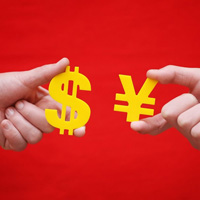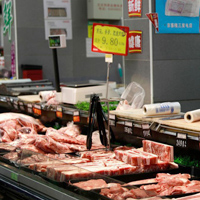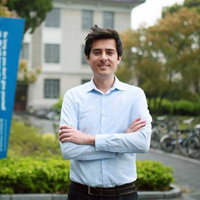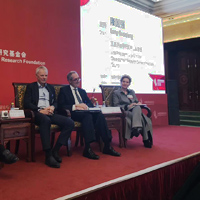-

【CGTN】CCG offers 10 suggestions to ease Sino-US trade tensions
The Center for China and Globalization (CCG), a Chinese independent think tank based in Beijing, has suggested 10 measures aimed at fostering stable Sino-US trade ties, as the tensions between the world’s two largest economies immediately rippled through markets and countries.US President Donald Trump inked a memorandum last Friday to impose punitive tariffs on imports from China. The Chinese Ministry of Commerce reacted with retaliatory measures against US products.CCG recommends that the Chinese government moderate its response to US actions and continue to adhere to the goal of long term stable economic and trade relations between the two nations via the following 10 suggestions:VCG Photo1. Campaign for a new mode of analyzing trade effects that would more accurately reflect how much US companies gain from the bilateral trade deficit, given the forces of the global value chains. Insist on including trade in services that China runs a large deficit with the US, such as tourism, education spending, immigration-oriented investments in the trade deficit analysis.2. Lift the excessive export limits, especially on high tech products from American companies. This could be beneficial for US enterprises and would help balance the trade deficits of both nations.3. Increase imports from the US, including consumer goods, energy, and agricultural products while reducing tariffs on goods such as automobiles and other high-value-added American products that are not central to the national economy, therefore fulfilling China’s WTO commitments.4. Improve business environment and implement policies that have been long called forth to reduce barriers of market entry for US companies.5. Promote the agreement between China and the US on cross-border e-commerce to benefit small businesses and consumers in both countries with substantial employment opportunities.6. Extend the protection of intellectual property rights to foreign companies or taking foreign IP regulations into account.7. Consider the establishment of an investment fund to help the US upgrade its infrastructure, capitalizing on China’s advanced technology and expertise in the field.8. Enlist the participation of American companies in Belt and Road projects as third party partners.9. Seize the opportunity to join the CPTPP discussions and facilitate the progress of multilateral trade systems building such as WTO, RCEP to sustain the momentum for global free trade.10. Appeal cases of US violation of the WTO rules to the appellate body.From CGTN,2018-3-27
2018年3月28日 -
原国家外经贸部副部长龙永图:不赞成“贸易战”的说法
“特朗普宣称将对600亿美元中国商品征收关税,舆论认为特朗普打响了对华贸易战。我一直不赞成用‘贸易战’这个词,太dramatic了。特朗普是发起对中国的贸易政策行动,他完全有权利这么做,中国也做出了回应。”原国家外经贸部副部长、中国入世首席谈判代表龙永图在3月27日举行的首届CGTN•CCG高端论坛上称。 “对很多人来说600亿美元当然是很大一个数额,但考虑到中国一年出口2万亿美元,600亿美元占比其实很小,so what?而且不是说600亿全泡汤了,只是交点关税。贸易本身就是一个交易、妥协、谈判的过程,这是市场行为,无需过度解读。”龙永图说。 龙永图介绍称,中国入市以后,“双反”战打了很多,但国际贸易仍在发展。真正具有威胁的是“中美贸易战”这个概念对市场信心的冲击,此时舆论应该有一个准确的解读,让市场平稳下来。“最怕一知半解的专家,对很多事情缺乏准确解读。” 龙永图说,中国入世最大的成果是引入了“双赢”的理念,习近平主席提出了新的升级版——“你中有我,我中有你”的“人类命运共同体”。“我们需要思考,如何将这个深刻的思想在国际外交等领域真正地表达、真正地解读。” 全球化智库(CCG)建议采取以下措施应对目前中美贸易紧张局势:从全球价值链角度来解读中美贸易赤字;美方放宽包括高科技公司在内的对华出口限制; 降低汽车、手机等普通消费类产品的关税;适度扩大对美油气、农产品等进口;切实加强知识产权保护的投入与力度;积极加入TPP 推动多边贸易体系;利用WTO 平台形成对美反制。 在论坛上,中国国际电视台(CGTN)与全球化智库(CCG)签署战略合作协议。文章选自21财经,2018年3月27日
2018年3月28日 -
龙永图:特朗普实际只是对中国发起了一个贸易政策行动
龙永图今天表示:特朗普实际只是对中国发起了一个贸易政策行动。不赞成用贸易战这个词。这只是一个市场行为,应该有准确的解读。 3月27日,中国国际电视台(CGTN)与全球化智库(CCG)在北京签署战略合作协议。中央电视台新闻中心副主任、CGTN外语频道总监江和平,CCG主席、国家外经贸部原副部长龙永图,CCG理事长、国务院参事王辉耀出席了签约仪式。出席该仪式的还有百余位国内外专家学者、政商界精英和媒体代表。 在签约仪式上,龙永图和江和平先后致辞,强调CCG与CGTN的深入合作能有效地、充分地利用双方优势,为国际社会贡献更多的优质思想产品,为全球化治理贡献中国智慧和方案,为增进中国和世界的相互了解搭建桥梁。 随后,江和平与王辉耀作为双方代表签署了战略合作协议。根据协议内容,双方将发挥各自优势,推进更深层次的战略合作:发挥智库专家优势,利用智库网络,联合组建专家委员会;定期组织对国际热点新闻的评述和研判,并为内容产品提供咨询;运用双方全球网络,组织国际交流活动,开展国际合作;依据评论等节目内容,定期出版建言献策和研究报告;联合发布年度舆情报告;根据新闻性,传播推动全球化和中国发展建设的智库研究成果等。 2016年12月31日开播的中国国际电视台(CHINA GLOBAL TELEVISION NETWORK)是集多语种、多平台为一体的融媒体传播机构,下辖英语、西班牙语、法语、阿拉伯语、俄语、英语纪录6个电视频道及北美、非洲、欧洲3个海外分台、1个视频通讯社和1个以移动新闻网为核心的新媒体集群,现有全球电视用户3.87亿,新媒体用户超过1亿。 CGTN旨在为全球受众提供准确、及时、客观的新闻资讯服务以及多元、平衡的观点。 CGTN从中国的视角报道世界,从世界的角度报道中国。同样的世界,不一样的报道!同样的报道,不一样的观点!自开播以来,CGTN始终坚定文化自信,坚持新闻立台,全面贴近受众,实施融合传播,以丰富的信息资讯、鲜明的中国视角、广阔的世界眼光,讲好中国故事,传播好中国声音,让世界认识一个立体多彩的中国。 全球化智库( Center for China and Globalization),简称CCG,成立于2008年,总部位于北京,在国内外有10个分支机构或海外代表处,目前拥有全职智库研究和专业人员近百人。秉承“以全球视野,为中国建言;以中国智慧,为全球献策”宗旨,CCG致力于全球化、全球治理、国际关系、人才国际化和企业国际化等领域的研究,是中国领先的国际化社会智库。CCG成立10年来,已发展为中国推动全球化的重要智库。在全球最具影响力的美国宾夕法尼亚大学《全球智库报告2017》中,CCG位列全球顶级智库百强榜91位,成为首个进入世界百强的中国社会智库,并在全球最佳社会智库榜单中被评为中国社会智库第一。同时,CCG在国内多个权威智库排行榜中也获高度认可,在南京大学与光明日报发布的《中国智库索引CTTI2017发展报告》中蝉联社会智库Top10榜首,并入选中国社会科学院《中国智库综合评价AMI研究报告(2017)》“核心智库榜单”。 作为中国极具影响力的国际知名传播品牌,和排名百强的国际化社会智库,双方强强联合,将集聚双方全球化研究、国际传播和全球网络优势,为展示中国形象、加强与世界的沟通提供更好的平台,同时也为重塑全球经济增长动力、实现可持续发展目标贡献中国智慧和方案。 签约仪式结束后,中国国际电视台(CGTN)与全球化智库(CCG)举办了首届CGTN?CCG高端论坛,这也是两会后首个媒体与智库融合论坛。 2018年是全面贯彻党的十九大精神的开局之年,也是中国面向新挑战新机遇的一年。近年来,中国积极适应和引领新常态,经济发展取得历史性成就,成为世界经济增长的主要动力。但与此同时,世界政治经济局势仍旧错综复杂,新时代中国所面临的国际舆论环境不容乐观。媒体和智库作为中国软实力的代表,对传递中国声音、积极传播中国开放发展的新气象新作为起着重要所用。 在此背景下,论坛围绕“媒体与智库如何引领新时代社会发展的风向标?”这一主题展开讨论。国务院参事、中国人民大学国际关系学院学术委员会主任时殷弘,中国国际问题研究院欧洲研究所所长、研究员崔洪建,布鲁金斯学会高级研究员David Dollar,中国国际问题研究院美国研究所所长兼军控与国际安全研究中心主任滕建群,外交学院战略与和平研究中心主任苏浩,英国东亚委员会秘书长麦启安(Alistair Michie),北京外国语大学英语学院副院长、教授谢韬,苏世民书院常务副院长潘庆中,清华大学国家战略研究院研究员寿慧生,商务部欧洲司原司长孙永福,北京大学国际关系学院教授王勇等专家学者参与了该研讨,分别就“2018年中国新政策信号”、“应对世界不平等挑战”以及“改革开放新征程”等话题分享了各自的观点和看法。文章选自华夏时报网,2018年3月27日
2018年3月28日 -

【Los Angeles Times】China announces retaliatory tariffs on 128 US products
A pork counter in a supermarket in Beijing. China is set to levy tariffs on $3 billion worth of U.S. goods after President Trump announced plans to impose tariffs on some Chinese imports. (How Hwee Young / EPA/Shutterstock)BEIJING — China on Friday announced it would impose retaliatory import tariffs on 128 U.S. products — goods that amount to $3 billion — targeting staples that include California wines, fruits and almonds.The move follows President Donald Trump’s decision this week to slap tariffs on about $50 billion worth in Chinese goods, triggering a potentially damaging trade confrontation with Beijing.Officials said the proposed actions were in response to the White House’s previous tariffs on steel and aluminum, which took effect Friday. But the timing, hours after Trump made his White House announcement impose tariffs specifically aimed at China, sent an unmistakable message.The lopsided responses — China’s ministry of commerce posted a relatively staid comment on its website — signal vastly different strategies between the world’s two largest economies in an escalating dispute that has raised fears of a trade war. Trump wants quick action and big results. China is aiming for restrained, targeted movements — an attempt to ward off a full-on conflict, but also show it won’t cede too much ground.“China is playing this very smartly, doing just enough retaliation to prove it’s serious,” said Arthur Kroeber, managing director of Gavekal Dragonomics, a Beijing research firm. “It’s doing what it can to position itself as the global good guy, with a fair amount of success.”The Chinese tariffs would first hit U.S. products such as avocados and nuts, with 15 percent tariffs. Beijing, if officials deemed it worthwhile, could also place 25 percent tariffs on American-made goods such as pork and aluminum. Friday’s statement did not indicate a specific date the tariffs would go into effect, but noted businesses had until March 31 to offer opinions. It said officials would “take legal action within the framework of the World Trade Organization.”This announcement did not mention Trump’s latest tariffs, which follow an investigation into China’s intellectual property practices and its harm to American businesses. Officials, as expected, found that China forced U.S. companies to hand over their trade secrets or make unfair concessions for access to its vast market.But in a separate statement, Chinese officials called Trump’s intellectual property investigation “typical unilateralism and trade protectionism.” China doesn’t want a trade war, it said, “but is absolutely not afraid of a trade war.”Trump’s announcement battered the stock markets in Asia and the U.S., where the Dow Jones sank more than 700 points before its close on Thursday.Analysts struggled to immediately understand why items such as wine, a product from the Democratic stronghold of California, would make the list but not top U.S. imports such as sorghum and soybeans. Chinese officials last month launched a probe into American sorghum imports, and both agricultural products come from regions more supportive of Trump.“We are technically in rhetorical territory here,” said Andrew Polk, co-founder of Trivium China, a Beijing-based research firm. “There is a small window to effect policy … they’re going to make a little noise, but then they’re going to let U.S. industry and the stock market do the talking for them.”The White House will publish the list of targeted goods within the next 15 days, and authorities may be waiting until they see the breakdown or face even heftier actions. China’s top economic officials, a number of whom were educated in the U.S., are known for their savvy of the American system and its electoral cycles.“For Trump, it is easier to blame other countries for the U.S.’ problems and garner votes in the mid-term election, instead of taking the pain to restructure the country’s economy,” China Daily, a state-run English newspaper, said Friday in an editorial. “He cannot force China to give in, however, because China knows the U.S.’ demands are insatiable.”China is one of the world’s most protectionist countries, and American businesses have long complained about requirements to create joint ventures or sacrifice proprietary information. The Treasury Department, alongside the tariffs, will restrict Chinese investment in American tech firms.Trump’s tariffs reflect beliefs that years of negotiations have failed, and China now threatens its security and success in areas like artificial intelligence. China, under President Xi Jinping, has sought to strengthen its advanced industries and global standing. Officials view the U.S. domination of leading technologies as a challenge to its own interests.The U.S. is essentially demanding that China “provide as much market access to the U.S. as the U.S. provides to China,” said Scott Kennedy, an expert on China’s economic policy at the Center for Strategic and International Studies in Washington. “That’s a really big list for China. Xi Jinping is a nationalist … and he’s not interested in giving the U.S. or anyone else a level playing field.”Trump likes to prove his point by highlighting a growing trade deficit with China, which reached a record $375 billion last year, according to the U.S. Commerce Department. While the latest tariffs could hit certain sectors, its macro impact on China’s GDP is still minimal, said Wang Tao, head of Asia economics at financial UBS investment bank in Hong Kong.Trump’s steel tariffs would affect China even less, as the nation makes up only 2.5 percent of U.S. steel imports due to existing regulations.But the latest moves hinted at the start of what could become a tit-for-tat battle that cracks global supply chains and increases costs for consumers. Trump’s announcement came the same day he replaced national security adviser H.R. McMaster with John Bolton, a former United Nations ambassador who advocates a more aggressive response to China.“It all becomes some kind of battle for supremacy,” said Louis Kuijs, head of Asia economics for global forecasting firm Oxford Economics. “If we take President Trump at his word, this is not the end.”The ramifications could extend well beyond trade in goods. About 350,000 Chinese students study in the U.S., and Chinese tourists spend more money here than those from any other country, noted Wang Huiyao, president of the Center for China and Globalization(CCG), a Beijing-based think tank.“Rather than just look at goods trade, we should look at services, infrastructure, e-commerce,” he said. “We should expand those things as well, rather than just focus on the goods movement. The calculation is out of date, the theory is out of date, and the mentality is out of date.”From Los Angeles Times,2018-3-23
2018年3月27日 -

【Xinhua】Foreigners see promising opportunities in China
SHANGHAI, March 23 (Xinhua) -- Learning Chinese in the weekend with his wife and daughter, Tim Byrnes, a 40-year-old quantum physics researcher from Australia, is really starting to feel like he fits into China.After doing research in Japan for over a decade, Byrnes became an assistant professor of physics at Shanghai New York University (NYU Shanghai), a Sino-American higher education institute, in 2016.He considers China a great place to do quantum technology research."Few other countries have a very advanced satellite with quantum capabilities like in China, and there is a lot of investment going into this area, especially from the private sector," he said.Recruitment of high-level talent is part of China’s efforts to drive growth of its economy, which has transitioned from a phase of rapid growth to a stage of high-quality development.In order to lure overseas professionals, the Chinese government at central and local levels is offering incentives including easier processing of visa and residence permits, large cash payments, and research subsidies.Byrnes thinks of himself as fortunate. Since moving to Shanghai, he has obtained four grants, including two from the National Natural Science Foundation of China and one from the Shanghai government.He was also included in the "Thousand Talent" program, a government initiative to attract top global talent to work in China.The program offered him a 500,000 yuan (around 79,000 U.S. dollars) research subsidy and promised to provide further research subsidy installments.Byrnes said that without these grants, he would not be able to conduct experiments in collaboration with other researchers as that requires a significant amount of money."In other countries, I would have to gradually work my way up," he said. "But now, I am already free to do new research and have my research team."BRIDGING TALENT GAPChina’s economy has moved from fast growth to enter a period of medium-high growth and high-quality development, along with an upgraded economic structure and innovation. The changes in the world’s second largest economy are driving demand for skilled workers, entrepreneurs and talented people in various fields.China plans to set up a state immigration administration under the Ministry of Public Security, as the number of foreigners working and living in the country has been rising, creating new requirements for immigration administration and services.In January, the country announced a new R visa for foreign professionals and high-skilled workers who visit China frequently. The visa has a validity of five to 10 years and allows multiple entries with a maximum stay of 180 days per entry.In late February, Hangzhou, capital of east China’s Zhejiang Province, rolled out new measures to attract foreign talent, including offering subsidies ranging from 200,000 yuan to 5 million yuan for foreign entrepreneurs.Other measures include facilitating applications for permanent residence, entry-exit visas and residence permits for top-level foreign talent. The city also plans to have 10 international schools by 2022.Also in February, Beijing released 20 new rules that were targeted at foreign professionals, aiming to improve recruitment and entry and exit procedures, as well as enhancing social security services.A MAGNET FOR TALENTMiao Lyu, secretary general of the Center for China and Globalization(CCG), a Beijing-based think tank, said that the mobility of science and technology talent, the core of innovation, across borders is expanding, and the competition between countries to attract talent is intense.Miao added that China’s talent introduction policies can help drive its economic and social development, especially the progress of local strategic emerging industries."Also, China’s fast economic development has improved its attractiveness to global talent," she said.According to the Expat Explorer 2017 Report published by HSBC, as one of the world’s economic powerhouses, a move to China offers expats numerous career and income advantages.Seven in ten expats in China said the country offers strong job prospects compared with only five in ten globally. Half of all expats interviewed in China said they have more chances to acquire new skills here than at home, and they earn significantly more than the average expat.The number of foreign employees in China has increased at a staggering pace over the past decades. More than 900,000 foreigners were employed on the Chinese mainland in 2016, according to official data. In the 1980s, less than 10,000 foreign experts worked in the country every year.The change has also been felt by Byrnes. "It is amazing that I often run into one of my old friends in another Chinese university and find out they started a career here," he said.From Xinhua,2018-3-23
2018年3月27日 -

【中国青年报】关于中美贸易,市场有自己的声音
美国前贸易代表苏珊·施瓦布(右一)和迈克尔·弗罗曼(右二)参加在北京召开的中国发展高层论坛2018“全球价值链重塑”分论坛全球化是人类社会取得的最大成就之一 不出所料,到北京出差的美国前贸易代表苏珊·施瓦布和迈克尔·弗罗曼,同时被问到了一个与他们无关的问题:中美两国最近的贸易摩擦。 这是在3月24日下午国务院发展研究中心主办的中国发展高层论坛2018年会上,提问者是“全球化智库(CCG)”理事长王辉耀。他在抛出问题前调侃:“你们现在来到中国,这个时间很巧,可能有点‘不幸’吧。” 此前一天,美国总统特朗普宣布对从中国进口的商品大规模征收关税,中国随后宣布采取反制措施。 王辉耀请教的是,特朗普的所作所为会不会破坏世界贸易组织(WTO)建立的多边贸易框架。施瓦布坦言,她对回答这个问题“比较迟疑”。她首先声明:“我们不代表现任政府。” 她说,美国政府采取的限制贸易的干预措施,当然会对贸易体系带来破坏,自己对此也很关注。无论美国、中国还是欧盟,政府的干预政策都会造成这样的后果。 弗罗曼表示,很“感谢”特朗普总统的所作所为,让贸易变成人们关心的焦点问题。他同意苏珊的分析,并认为这其实是特朗普的一种“去全球化”策略。 而他们担任美国贸易代表时的谈判对手、中国商务部前部长陈德铭表达的更加直接。他说,以规则为基础的国际贸易和多边的贸易组织,是全球价值链能够发展的根本保证。单边主义和贸易保护在这儿是行不通的。对世贸组织的规则有看法,可以坐下来谈,而不是“自己搞一套规则来反对现在的规则”。 他还说:“脱离了世界贸易组织的惩罚性关税,容易引起贸易战,历史已经证明并将继续证明这样的做法会损人害己,最后谁也不是赢家。” “向保护主义压力低头会让所有人受害” 两天以来,“中美贸易”在议题十分丰富的中国发展高层论坛上是个高频词。在主题为“金融市场稳定与发展”的午餐会上,哈佛大学前校长、美国前财政部长劳伦斯·萨默斯形容:“大家可能现在脑子里想的就是这样一个问题——贸易以及中美关系。” 就连新上任的中国人民银行行长易纲都没避开这个问题——中美贸易争端造成了资本市场的大幅波动。他对此表态说,市场波动时有发生。中国的银行体系、证券市场、保险市场以及货币数量和价格的变量调控,“我觉得是完全可以防范和化解这些风险的”。 国务院发展研究中心主任李伟指出,个别国家新推出一系列以自我利益为中心的贸易保护政策,与现行基于规则的全球贸易体系的宗旨相悖,这可能会引发其他主要经济体的跟进效仿,从而使二战后建立的全球贸易体系可能处于一种大变革的关键时期。 作为世界贸易组织前总干事,帕斯卡尔·拉米此次更是不断被要求谈到这个问题。“美国的关税举措是会让大家重新谈判还是会毁掉世界贸易体系,我不知道答案。”他说,“大国角力的结果是非常危险的。” “我们不想看到贸易争端变成贸易战。”澳大利亚前总理陆克文开玩笑说,他早已卸任总理,而且已在美国居住了4年,作为一个“全球公民”,说话可以随便一些。 “我比较担心全球贸易以及基于规则的贸易体系的走向,如果崩溃的话,备选方案就是适者生存,老大就能独裁,指挥别人。”他说。 陆克文表示,他比较担心的是美国总统可以轻轻松松就把关税、保护主义武器甩出来,“我觉得不能这么轻率”。他说,多边贸易体系是基于规则的演进形成的,是过去几十年取得的难得成绩。对中美之间的贸易争端,世贸组织作出了裁定,但美国忽略或是无视了裁定,违背了协定精神。 在拉米看来,美国是世界上唯一一个拥有“保护主义日程”的主要经济体。“我们现在非常明确地知道,向保护主义压力低头会让所有人受害。” 拉米强调,多边贸易体系并不完美,他本人也明确认为有必要进行改进,但是改进必须通过谈判来实现。21世纪的国际贸易需要的是基于规则的游戏,而不是基于实力或强权的游戏。美国并不是唯一觉得世贸组织体系存在问题的成员。关于体系如何改进、规则如何改进,第一个计划应该是大家坐下来谈判。如果这个计划行不通,至少要确保那些主张多边贸易体系应进一步加强而不是削弱的成员,在世贸组织的框架下成立一个必要的联盟。因为世贸组织是一个全球性的包容性机构,即使一些成员不认可它的价值,其他成员也可以继续在世贸组织内合作。 “我们不希望和任何国家打贸易战” 3月25日,出席论坛的中国商务部副部长、国际贸易谈判副代表王受文就此表态:“我们不希望和美国打贸易战,我们不希望和任何国家打贸易战,但是如果中国的利益受到了损害,我们不得不采取一些措施来捍卫我们的利益。我们希望中美两个大国在WTO框架下坐下来磋商来解决分歧,贸易战没有赢家,我们希望双方能够理性采取措施解决我们之间的分歧。” 他说,中美贸易关系是互利双赢的关系。两国建交以来,贸易增长了230多倍,双方都取得了利益。在这么大的贸易关系之中,出现一些摩擦是难以避免的。问题是对这些摩擦怎么处理。中美有摩擦有矛盾可以在WTO共同的规则下来处理。 根据陆克文的判断,从中美两国迄今公布的关税清单来看,还没有涉及双方经贸关系里的核心利益。他认为这是一个信号,表明双方还在寻求问题的解决。 “谈判里不可控的一部分是特朗普总统本人——我们不知道他今天是不是还记得昨天讲过的话。”陆克文说,“作为美国的盟友,像中国一样,我们也有对特朗普的顾虑,他是美国国内政治体制独特的产物。祝美国人好运,这是美国人不可控的变量。” 耶鲁大学高级研究员史蒂芬·罗奇也认为,美国的政策是受总统“飘忽不定的思路”决定的。因此,他担心的是两个最强大、最有活力的经济体之间的经济关系,有恶化的风险。 此次在北京,劳伦斯·萨默斯应邀演讲的主题是中美关系,他呼吁中美开展对话与合作。不过在他看来,中国政府愿意本着长期战略性的眼光来思考问题,而美国现届政府更多以交易性的短期视角来看待世界。“这就让我所呼吁的这种对话更加难以成行,因为双方对‘成功谈判’的理解是不一样的。”打贸易战是没用的,市场有自己的声音 在演讲中,萨默斯强调,我们现在需要意识到,美国的经济命运很大程度上受到日本、中国、印度、德国等很多国家的影响。在今天这个世界,美国将继续扮演一个独特的角色,但不是像冷战结束时那样一枝独秀的角色。中国与美国如果致力于建造一种法制框架和程序来管理商业的纠纷,就能够让世界更加美好,这是完全可以做到的。“美国最终未来会理解到,美国不可能一边打压中国一边自己还实现好的发展,这点他们一定会意识到的。” 萨默斯引用美国前总统里根的话说,核战没有赢家,因此不能打核战,贸易战同样如此。贸易战最大的后果就是心理上的威慑,但对GDP的影响、对供求的真正影响可能很小。 世界贸易组织首席经济学家罗伯特·库曼也认为,看特朗普的举动,大家似乎会对全球贸易有一种悲观的情绪,但看贸易数字,全球贸易其实发展得不错,全球经济走势让贸易最近有所恢复。“虽然有这些不容乐观的事件在发生,但是这些事件不会对全球贸易造成致命性的冲击,可能会让全球贸易的势头稍微或暂时受到抑制。”他强调,毕竟全球贸易的发生取决于消费者的需求,而不是政府的想法。 “特朗普不一定非得听我的——他只要去听一下市场的声音。”美国贝莱德集团首席执行官劳伦斯·芬克指出,打贸易战是没用的,市场有自己的声音。全球化是人类社会取得的最大成就之一,中美两国都因全球化而受益,全球不想看到也不需要中美之间打贸易战。 美国苹果公司首席执行官蒂姆·库克说:“我的经历告诉我,拥抱开放、拥抱贸易、拥抱多样性的国家,就能获得成功。而那些拒绝开放、拒绝贸易的国家就可能会失败。我觉得大家通过合作可以把蛋糕共同做大,并不是说去争夺一块蛋糕。”文章选自《中国青年报》,2018年3月日
2018年3月27日 -
钢协新任会长于勇:中国钢铁故事应该这样讲!
理事简介于勇,全球化智库(CCG)副主席,河钢集团党委书记、董事长。在中国钢铁工业协会2018年理事(扩大)会上,河钢集团党委书记、董事长于勇当选为中国钢铁工业协会新一任会长。他指出:“2018年,是我国改革开放40周年,钢铁工业将进入高质量发展的重要阶段。在这一重要历史节点,大家推选我为新一任会长,深感责任重大,我将恪尽职守,不辱使命,和广大会员单位一道,深入贯彻落实党的十九大精神,高举习近平新时代中国特色社会主义思想伟大旗帜,不忘初心,牢记使命,改革创新,奋发有为,为实现中华民族伟大复兴的中国梦贡献钢铁力量。”会议召开期间,于勇就中国钢铁工业提质增效、绿色发展和钢铁工业走出去等热点问题接受了《中国冶金报》、中国钢铁新闻网记者的专访。他表示,中国钢铁故事应该这样讲——全方位提高质量意识。实现中国产品向中国品牌转变 “‘由高速增长阶段转向高质量发展阶段’,是以习近平同志为核心的党中央对中国经济历史新方位作出的科学判断,是习近平新时代中国特色社会主义思想的重要组成部分。历经改革开放近40年的快速发展,我国综合国力大幅提升,以经济增速从高速增长转向中高速增长为代表的多重转向,推动中国经济进入转向高质量发展阶段的历史性‘窗口期’。”于勇介绍,十八大以来,河钢坚持走产品高端路线,以客户结构的优化推动产品升级,围绕解决影响“满足客户需求”和“增加有效供给”的重点问题,拓展工作新方法和新路径,实现了产品结构的快速提升和效益空间的强力释放,找到了河钢高质量发展的“路径自信”。 “2018年,河钢将把产品结构和客户结构优化作为全年工作的重中之重,持续推动‘两个结构’在产业中高端进阶。”于勇表示,“未来,客户结构的调整将是拉动河钢产品结构升级的最大引擎,河钢将通过加强与高端客户的战略合作,在占领高端市场、进入高端领域、参与重大工程中锻造品牌实力。”同时,河钢还将抓住我国正处于向工业化后期过渡这一关键历史机遇,深度研究下游及新兴产业,建立跨界材料方案研发机制,加速向为客户提供全面钢铁材料解决方案的综合服务商转变,并通过掌握新工业革命的核心技术和理念,快速推进转型升级,成为新竞赛规则的重要制定者、新竞赛场地的重要主导者,实现从“跟跑”向“领跑”的跨越。循环经济、低碳经济、绿色经济应成为行业新的经济增长点 “党的十九大报告把坚持人和自然和谐共生作为基本方略,进一步明确了建设生态文明、建设美丽中国的总体要求。” “随着自然环境约束的加强和社会对环境认知的加深,以及钢铁工业污染物排放系列标准和能源消耗限额标准指标的加严,加强监察监管、严肃问责已成为企业节能环保工作面临的新常态。”于勇表示,“面对环保达标、节能降本的双重压力,绿色发展已经成为我国走新型工业化道路、调整优化经济结构、转变经济发展方式的重要动力,进一步加大绿色发展投入,实施绿色制造,生产绿色产品,是钢铁行业持续健康发展的必然选择。”“钢铁行业的绿色发展之路,本质上是一条以低消耗、低排放和资源高效循环利用为主要特征的道路。这与钢铁行业未来发展大势同向同行,必须坚定不移地持续推动。”于勇强调,“钢企应通过对标国际最先进的能耗指标,加快节能技术的改造推广,发挥再生资源的最大价值,实现现有技术条件下能效水平最优。在“一带一路”建设中增强中国钢企参与全球竞争的能力与自信 “2018年,是深入贯彻落实党的十九大精神的开局之年,也是改革开放40周年,国家深入推进供给侧结构性改革、京津冀协同发展、‘一带一路’建设,将为河钢带来前所未有的历史机遇。”于勇说,“习近平总书记指出,国有企业要成为实施走出去战略、‘一带一路’建设的重要力量。顺应国家战略,推进企业发展,既是国有企业肩负的责任和使命,也是其实现自身发展的必然选择。只有契合国家战略,才会顺应时代进步要求,才能乘势而上获得更加广阔的发展空间。” 于勇表示:“河钢集团作为中国最大的钢铁材料制造和综合服务商之一,必须坚决贯彻执行党中央决策部署,在打造中国开放型经济中展现使命和担当。”他认为,河钢塞尔维亚公司的全面盈利,河钢项目在南非等“一带一路”沿线国家和地区的成功运营,以及河钢在欧美等发达国家和地区投资项目呈现出的良好发展态势,让河钢积累了在不同国度、各种社会环境中经营企业的成功经验,增强了中国钢铁企业在世界经济中参与竞争的能力与自信。在国际化发展过程中,中国企业历史上是以低成本产品输出为主。“中国钢铁工业经过改革开放近40年的时间完成了欧美发达国家100多年的发展历程,综合竞争力达到世界先进水平,完全具备了资本、技术和管理输出的实力和参与全球竞争的成熟条件,我们需要也完全能够在世界舞台上找到属于中国制造业的席位,向世界展示中国形象,发出中国声音,讲好中国故事。”于勇告诉《中国冶金报》、中国钢铁新闻网记者,河钢海外发展,一是依托全球营销服务和投融资平台、全球钢铁材料制造平台、全球技术研发平台三大平台,持续提升国际化发展质量,包括加强境外资产风险防范和经营管控,保持经营业绩持续增长;优化出口产品结构,对接国际高端客户,提高高端产品出口比例;推进丝路能源钢铁公司项目实施,促进河钢德高发展战略转型;加快河钢塞尔维亚公司技改项目进展,调整产品结构,挖掘降本空间,提升产量水平。二是在“一带一路”沿线国家和地区及高端制造、经济发达地区寻求投资项目,加快欧洲钢铁制造基地战略布局;推进中塞友好工业园区建设,快速推动园区发展项目落地。三是深化国际技术交流合作,发挥全球技术研发平台支撑作用,积极推动前沿技术研究和科研成果转化,以蹄疾步稳的节奏加快国际化发展,将外部条件转化为自身竞争优势,把“大有可为”的利好环境变成“大有作为”的发展平台,在擘画新的发展蓝图中砥砺前行。文章选自轧钢之家,2018年3月9日
2018年3月26日